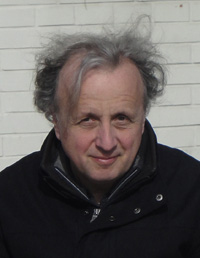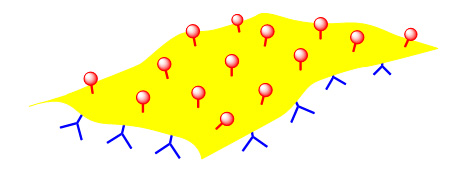Professor Dieter Schlüter, ETH Switzerland
Professor Dieter Schlüter has given 2 lectures during his most recent visit to the University of Florida:
March 14, 2011 - Leigh 309 - 4:00pm - "Polymers Going Rigid and Thick"
March 15, 2011 - NPB 1001 - 4:05pm - "Polymers Going Laterally Infinite"
See the announcement poster here.
 Dieter Schlüter has been full professor of polymer chemistry at the ETH Zürich Department of Materials since spring 2004. Born in Germany, he studied chemistry and geophysics at the University of Munich (LMU) and received a doctorate in organic chemistry 1984 with Prof. G. Szeimies. After post-doctoral work with Prof. K. P. C. Vollhardt (UC Berkeley) and Prof. W. J. Feast (U of Durham, England) he joined the Max Planck Institute for Polymer Research in Mainz in 1986, where he concentrated on synthetic macromolecular chemistry in the department of Prof. G. Wegener. In 1991 he received habilitation in organic chemistry at the University of Mainz. Shortly thereafter he was briefly an associate professor at the Polymer Institute of the University of Karlsruhe before accepting a chair professorship for organic and macromolecular chemistry at the Free University of Berlin in 1992, where he was until spring 2004. He has held and still holds numerous functions in organizations, on boards, in committees and alike. Presently he has about 250 peer-reviewed publications and several book chapters, and gave approximately 250 invited lectures all over the world. His research achievements are:
(1) Discovery of the Suzuki polycondensation, a powerful and worldwide used method for the synthesis of polyarylenes which made it into industrial application, (2) exploration of the polymerization of [1.1.1]propellanes, where CC sigma bonds can be made polymerize, (3) discovery of the first successful Diels-Alder polymerizations, through which access to high molar mass, soluble ladder-type polymers was provided, (4) recognized contributions to the field of shape-persistent macrocycles and fully aromatic double-stranded macrocycles, (5) discovery of the "dendronized polymers" as the largest synthetic and structurally defined macromolecules, (6) discovery of the first rational synthetic routes to two-dimensional (sheet-like) polymers. Dieter Schlüter has been full professor of polymer chemistry at the ETH Zürich Department of Materials since spring 2004. Born in Germany, he studied chemistry and geophysics at the University of Munich (LMU) and received a doctorate in organic chemistry 1984 with Prof. G. Szeimies. After post-doctoral work with Prof. K. P. C. Vollhardt (UC Berkeley) and Prof. W. J. Feast (U of Durham, England) he joined the Max Planck Institute for Polymer Research in Mainz in 1986, where he concentrated on synthetic macromolecular chemistry in the department of Prof. G. Wegener. In 1991 he received habilitation in organic chemistry at the University of Mainz. Shortly thereafter he was briefly an associate professor at the Polymer Institute of the University of Karlsruhe before accepting a chair professorship for organic and macromolecular chemistry at the Free University of Berlin in 1992, where he was until spring 2004. He has held and still holds numerous functions in organizations, on boards, in committees and alike. Presently he has about 250 peer-reviewed publications and several book chapters, and gave approximately 250 invited lectures all over the world. His research achievements are:
(1) Discovery of the Suzuki polycondensation, a powerful and worldwide used method for the synthesis of polyarylenes which made it into industrial application, (2) exploration of the polymerization of [1.1.1]propellanes, where CC sigma bonds can be made polymerize, (3) discovery of the first successful Diels-Alder polymerizations, through which access to high molar mass, soluble ladder-type polymers was provided, (4) recognized contributions to the field of shape-persistent macrocycles and fully aromatic double-stranded macrocycles, (5) discovery of the "dendronized polymers" as the largest synthetic and structurally defined macromolecules, (6) discovery of the first rational synthetic routes to two-dimensional (sheet-like) polymers.
Polymers Going Rigid and Thick
By A. Dieter Schlüter, ETH Zurich
After a brief excursion into the discovery of Suzuki polycondensation in 1988, some of the very recent exciting findings using this powerful method for the synthesis of polyarylenes will be described. One of them shows the Nobel-prize winning Suzuki cross-coupling reaction to be arguably the best method for CC bond formation.[1] In a second part it will be discussed how conventional polymer chains can be systematically thickened to the degree that they attain a persistent cylindrical shape and turn into molecular objects. A particular representative, a fifth generation dendronized polymer, is the largest ever synthesized macromolecule with structure precision. Quite some emphasis will be placed upon the aspect why thickening of polymer chains makes sense and to which applications this can lead.[2]

[1] R. Kandre, K. Feldman, H. E. H. Meijer, P. Smith, A. D. Schlüter, Angew. Chem. Int. Ed. 2007, 46, 4956-4959.
[2] B. Zhang, R. Wepf, K. Fischer, M. Schmidt, S. Besse, P. Lindner, B. T. King, R. Sigel, P. Schurtenberger, Y. Talmon, Y. Ding, M. Kröger, A. Halperin, A. D. Schlüter, Angew. Chem. Int. Ed. 2011, 50, 737-740.
Polymers Going Laterally Infinite
By A. Dieter Schlüter, ETH Zurich
The present interest in graphene, a naturally occurring two-dimensional polymer, makes clear that there is no synthetic method available that would allow accessing a covalently bonded molecular sheet with internal periodicity and a thickness of one monomer unit only.[1] After a brief overview of “organic” and “polymer” approaches performed so far, the concepts will be presented which are presently being pursued in the author’s laboratory. They rest upon carefully designed monomers, interfacial as well as single crystalline ordering, and both metal-complexation and light-induced polymerizations. The lecture will provide a state-of-the-art picture including the not yet published first solution to the problem.

[1] J. Sakamoto, J. van Heijst, O. Lukin, A. D. Schlüter, Angew. Chem. Int. Ed. 2009, 48, 1030-1069
|